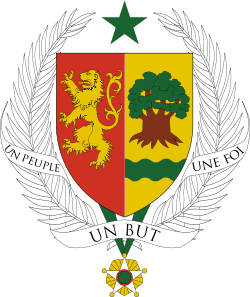Energy in Senegal
Senegal's major source of electricity is mostly diesel and gas, with an installed capacity of 633 MW.
Electricity sector
Following institutional reform in 1998, Senegal's electricity sector was split into three entities: Senelec, the national utility, the Agency for Rural Electrification (Agence Sénégalaise d'Electrification Rurale, ASER) and the Electricity Regulatory Board (Commission de Régulation au Secteur de l'Electricité, CRSE).[1][2]
Electricity generation, mainly on a Build-Own-Operate (BOO) basis, is open to the private sector. Senelec, the sole buyer, signs power purchase contracts with independent power producers (IPPs).
Electricity production

Senegal's major source of electricity is mostly diesel and gas, with an installed capacity of 633 MW.
- The General Electric/GTI Dakar IPP, which supplies approximately 20 percent of Senelec’s electrical needs, was commissioned in 1998. It has an installed capacity of 56 MW.
- On-line since January 2008, the second IPP Kounoune 1 – 67.5 MW - was partially funded by the International Finance Corporation, with Mitsubishi and Matelec S.A.L, a division of the Doumet group from Lebanon, as strategic partners.[1]
- Some hydroelectricity generated from the Manantali Dam in Mali is split between Senegal, Mali and Mauritania. Manantali has an installed capacity of 200 MW dispatched as follows: 52% for Mali, 15% for Mauritania and 33% for Senegal (66 MW).[1]
Electricity demand and supply gaps
Senelec is dealing with a chronic electricity production gap. which has worsened due to growing demand for electricity – the average demand increase during 2005-2009 is estimated at 7%, representing an electricity consumption of 1.933 TWh in 2005 to an estimated 2.66 TWh in 2009. The company is experiencing declining reliability of aging power plants.[1]
Senegal's GDP growth was hindered in 2007 by frequent electricity outages, which caused a slowdown of the economic and manufacturing activities. The GDP growth rate decreased to 2.1% in 2006 from 5.5% in 2005. According to local reports, the outages have contributed to the closure of many small and medium-sized enterprises (SMEs) in the food processing, textile and tourism sectors. Larger companies are reporting declines in output averaging 30%.[1]
Future development
Senegal is committed to shifting from a diesel-based power generation to cheaper energy sources. Senegal has thus put an option on the coal technology. The recent bid to build-own and operate a 125 MW coal-fired Sendou power station was awarded to a consortium of companies headed by the Swedish operator Nykomb Synergetics.[3] In addition, Senegal has embarked on an aggressive effort to produce significant quantities of biofuels, initially to run electricity generation units, and has a pilot project using sugarcane-based ethanol.[1]
References
- 1 2 3 4 5 6 Senegal Country Commercial Guide 2008. U.S. Commercial Service (2008).
 This article incorporates text from this source, which is in the public domain.
This article incorporates text from this source, which is in the public domain. - ↑ Loi n° 98-29 du 14 avril 1998 relative au secteur de l’électricité (in French)
- ↑ "Senegal to build new 124 MW coal-fired power plant". Forbes. 25 January 2008. Retrieved 18 February 2010.
